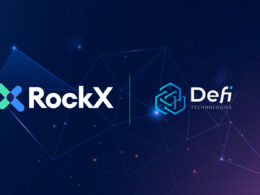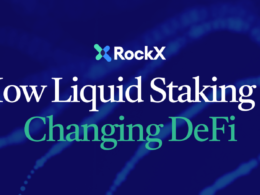The cryptocurrency market appeared to pick up speed from where it left off in 2017 amid the heyday of ICOs. This time, though, it is a different concept that is gaining traction and is regarded as a solution to the world’s unbanked crisis and the monopoly in the existing financial ecosystem.
The year 2020 was dubbed as the year of “Decentralized Finance” by those in the crypto and blockchain industries. In addition, the possibilities this concept brings to the table are expected to reach new heights shortly, all the while producing remarkable profits and increasing the popularity of decentralization at its core.

The whole idea of digital decentralized yield generation is arguably the most crucial aspect establishing the value of DeFi applications.
While no one can deny that unlimited projects incorporate a plethora of strategies, Yield Farming and Liquidity Mining are two terms that are stealing the spotlight and are used interchangeably. Although they may sound familiar and are built on similar concepts, they are two sides of the same coin.
The brief history of DeFi
For years now, making money in crypto was only subject to speculating on the market prices of cryptocurrencies.
However, when a bunch of people built software on top of the Ethereum network to add functionality to the online transactions, it made banking activities such as lending, borrowing, and insurance viable without the presence of any intermediary. Simply put, the concept of Decentralized Finance (DeFi) came to life.

It all started when one of the popular DeFi lending platforms – Compound, started distributing its governance tokens called COMP to its users on the network. On Compound, users were already involved in lending and borrowing activities, and “Yield Farming” is one such case of earning interest on deposits.
As the popularity of Compound’s token market cap grew, so did the excitement about “Yield Farming.” Other DeFi projects, including Binance and Yearn.finance, adopted this approach, inventing the term “Liquidity Farming” to describe the practice of handing someone a new token in exchange for injecting liquidity to the network.
But, the question still remains: how are the two different from each other?
Liquidity Mining Explained
In its broadest sense, liquidity mining is the process of earning tokens by supplying liquidity to DeFi platforms. It’s a type of network participation where users give the platform the resources it needs to operate seamlessly and get incentivized in return.
Liquidity mining is derived from two key DeFi concepts: liquidity and mining. Decentralized exchanges or platforms require liquidity to facilitate trade on these platforms and grow and expand the DeFi markets.

On the other hand, mining employs the Proof of Work method, in which liquidity providers receive new coins that the protocol’s algorithm has freshly minted. But mining is more broadly used as the concept of incentivizing a user for their contribution to the platform.
For instance, a new DeFi platform requires liquidity to provide services, and in exchange for this liquidity, it is ready to give governance tokens. The platform proposes a liquidity pool where interested users can make contributions.
In exchange, they receive both interest and governance tokens for the duration the tokens remain in the pool. These governance tokens create a decentralized network where the participants control the ecosystem and create a trustless network. This is how liquid mining profitability works.
Yield Farming Explained
Yield Farming is an approach that goes above and beyond conventional liquidity mining to maximize user returns by utilizing its essential qualities. Yield Farming is a strategy for putting crypto assets to work and getting the most profit out of them.
In this process, the user transfers its assets across various DeFi platforms for maximum rewards through liquidity mining and fund leverage mechanisms.

A yield farmer, for instance, will try to shift his assets throughout the Compound protocol in pursuit of the pool with the highest weekly APY. After a week, this farmer realizes that there is another pool, say Balancer, that offers higher APY for that period.
So now, this farmer will transfer the funds from Compound to Balancer. Similarly, funds are transferred between various protocols to generate the highest possible yield.
Moving assets around for maximum benefits is risky, but a yield farmer is prepared to take that risk.
The presence of Liquidity Mining is the cause behind Yield Farming’s enormous appeal, which explains why the terms are often used interchangeably. A yield farmer is entitled to both new tokens and regular returns because of the liquidity miner’s provided liquidity.
Risks in Yield Farming
Yield Farming isn’t everyone’s cup of tea. In fact, because of the complexity, the most profitable yield farming strategies are only recommended for advanced users. On the other hand, this type of money-making method currently suits the crypto space’s whales. To put it another way, only those with a large amount of money to invest.
In terms of risks, DeFi initiatives are made up of a variety of digital funds, smart contracts, and complex incentive systems, all of which are further complicated by protocol updates. Furthermore, problems and vulnerabilities are discovered regularly in these DeFi projects, putting user funds in even greater danger.
However, when compared to the current system’s vulnerabilities or monopoly, DeFi seems like a great alternative. Even though Yield Farming involves the element of risk, the high yields are enough to entice more people to participate apart from the trust and transparency.
Final Thoughts
In conclusion, Yield Farming differentiates itself from Liquidity Mining as a yield farmer is more inclined towards finding loopholes in the system to yield as many rewards as they can. So, Liquidity Minings risks are lesser than those of the former.
There is no one-size-fits-all approach to Yield Farming. Instead, there is a shift in yield farming tactics every hour and every minute because each protocol has its unique set of regulations and characteristics.
Nevertheless, the future of yield farming may include a number of new yield farming applications, some of which may offer profit-sharing as a reward option.
Yield farming and liquidity mining are crucial components of decentralized finance, which is on its way to bringing a financial revolution, and these concepts are at the core of this revolution.









